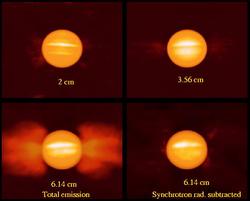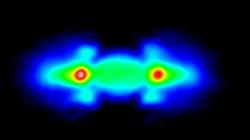|
Radio Emissions from Giant Planets:
Radio emissions in planets can occur within the magnetosphere and atmosphere.
Radio emissions in this case will occur in the millimeter and centimeter ranges.
The gas giant planets emit more heat than they receive so are more prone to emit
radiation in the radio bands. The most common form of radio emission is by way
of
Synchrotron Radiation - which is a non-thermal method of emission.
 |
Longitude-averaged images of Jupiter at wavelengths of 2, 3.5 and
6 cm; the latter image shows the total emission (thermal + non-thermal),
as well as an image where the non-thermal (synchrotron) radiation was
subtracted.
These images were taken close in time with the Galileo probe entry
into Jupiter's atmosphere, Dec. 7, 1995. |
Of the gas giants:
- Jupiter: the largest solar system planet, was first detected at radio
wavelengths of about 6 cm; the emission is dominated by synchrotron and
comes from electrons with energies in the range 1 to about 100 MeV. The
magnetic and rotation axes are misaligned by about 11 degrees. This causes
the field to wobble, and has a big effect on the charged particles around
the planet.
- Saturn: no synchrotron component is seen, although it would be there if
it were not for the presence of the rings, which disturb the relativistic
electrons. The rotation and magnetic axes for Saturn are quite closely
aligned.
- Uranus/Neptune: Uranus appears to have too weak a magnetic field to
produce synchrotron emission; Neptune might just have a synchrotron
component at about 20 cm.
Jupiter makes a great target for radio emissions!
 |
Left: Jupiter at 13 cm. This image was taken about a
year after the comet Shoemaker-Levy impacted Jupiter; the synchrotron
clouds around the planet had largely returned to normal. |
| Right: Jupiter at 22 cm. The synchrotron emission in
this band is much weaker than at 13 cm. |
 |
More information on the above images.
The practical range for radio emission observation of gas giant planets is
between 6 cm to 20 cm. Anything below 6 cm becomes to faint to detect. Peak
emissions at around 20 cm emanate from the magnetic field. In this case, the
emissions are not from the planet, but from solar radiation trapped in the large
magnetic fields of these planets.
In the case of Jupiter, additional material in this frequency range can also
come from Io. Notice the two small red circles in the two images above - this is
the orbit of Io and is called the
Io Plasma Torus.
Back to Top
|

